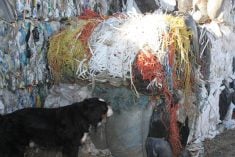B.C. adds forage help
British Columbia’s agriculture department has changed its crop and forage production programs to offer extra protection to livestock producers in the northern, central and Peace River regions.
Forage supply coverage is designed to provide better support for producers whose forage supplies are limited by floods, drought and other weather related issues.
To qualify for coverage, livestock producers must rely on forage produced on their own farm for the majority of their requirements and must have already bought the minimum level of forage production insurance.
Read Also

Message to provincial agriculture ministers: focus on international trade
International trade stakeholders said securing markets in the face of increasing protectionism should be the key priority for Canada’s agriculture ministers.
The deadline to purchase forage production insurance is Nov. 30.
For more information, contact a local production insurance representative in Dawson Creek at 877-772-2200, Fort St. John at 888-822-1345 or Kamloops at 888-823-3355.
Livestock assistance
Alberta livestock producers who are eligible for benefits under the Alberta Farm Recovery Plan can now begin applying for their second benefit.
The AFRP benefits were announced as part of the Alberta government’s livestock and meat strategy, designed to help the industry become more sustainable and profitable. Participants received their first benefit in June.
To receive the second instalment in early 2009, cattle producers are required to age verify their 2008 calf crop.
Eligible producers must also register their farm with Alberta Agriculture by Dec. 31.
Alberta Financial Services Corp. has sent application forms to all producers who received a benefit in June.
Others can acquire forms on-line at www.agriculture.alberta.ca/premises or on the Alberta Livestock and Meat Agency’s website at www.alma.alberta.ca.
Producers who believe they are eligible for AFRP, but have not received any previous benefits, should contact the financial services corporation.
Producers of all livestock species, including cattle, hogs, bison, elk, horses, donkeys, mules, deer, llamas, alpacas, vicuna, reindeer, sheep and goats, are eligible.
CWD tests get money
The Saskatchewan government is providing a $240,000 grant to the Canadian Co-operative Wildlife Health Centre at the University of Saskatchewan to monitor and control the spread of chronic wasting disease.
The money will be used to conduct tests on deer and elk samples submitted by hunters.
Although there is no evidence that chronic wasting disease can be spread to humans from the consumption of meat from infected animals, hunters have requested a testing service to help reassure them that the game meat they consume is CWD-free.
Testing helps to determine where the disease is located in the province, whether it is spreading and how many animals are infected in relation to the overall population.
More information about CWD and the 2008 program can be found on the Saskatchewan Environment website at www.environment.gov.sk.ca.














